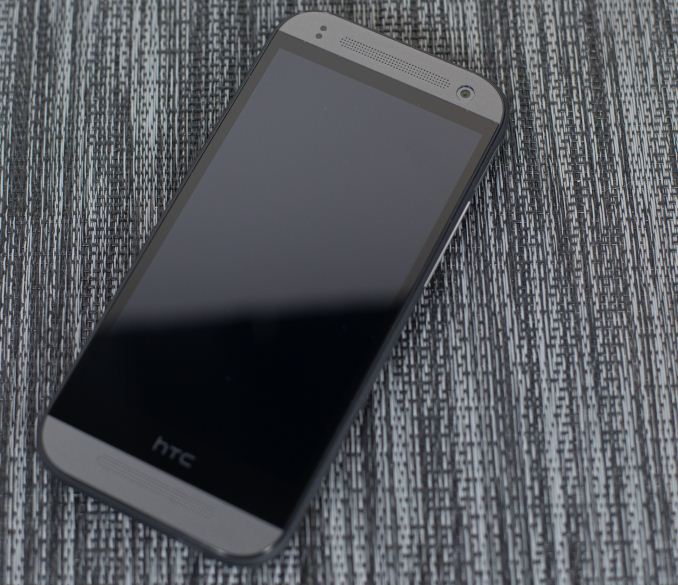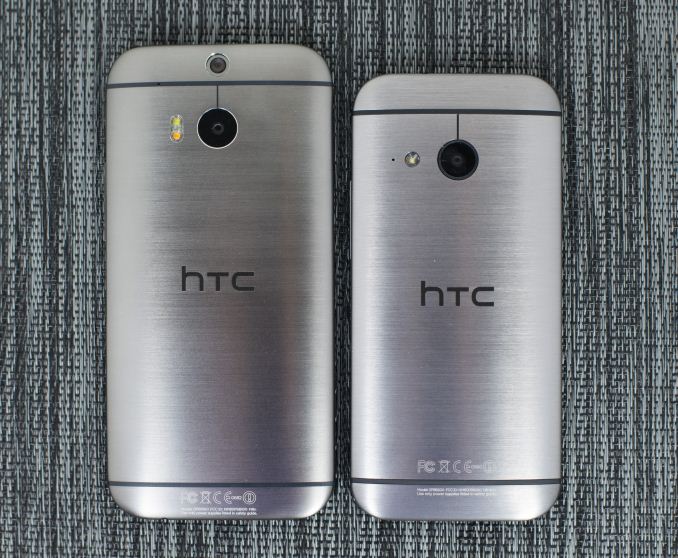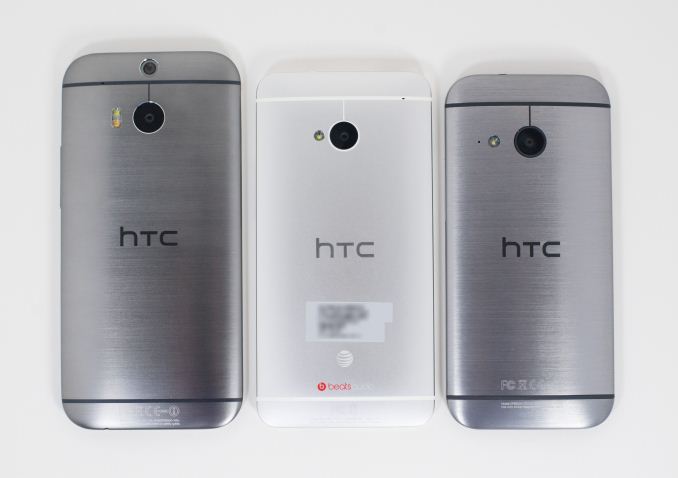HTC One mini 2 Review
by Anand Lal Shimpi & Joshua Ho on May 26, 2014 3:00 AM EST- Posted in
- Smartphones
- HTC
- Mobile
- One mini 2

Last year around this time, HTC had yet to release a mini version of its flagship phones. As OEMs continued to push bigger and bigger displays into bigger phones, there was a distinct push for a phone that had flagship specifications, but without the size that normally entailed such flagship specifications in the Android space. HTC then proceeded to launch the One mini, a phone that was the size that everyone had been asking for, but just wasn’t the same as its larger cousin. While there are now phones around the size of the One S that have flagship specs, the One mini was a distinctly midrange device, with a number of concessions made to reach a midrange price.
Of course, that was the past. Today we’re looking at the successor to the One mini. Unfortunately, for those that want everything in a One (M8) repackaged to fit into a phone the size of a One S, this is not that phone. However, the bigger question is how well this phone fits into the mid-range spectrum, and how well it compares to the competition. To this end, HTC seems to hope that better design and the halo effect from the One (M8) will differentiate the One mini 2 from the rest of the competition.
As always, the most immediate impression that one gets is from holding the phone, even before it’s turned on. In this respect, the One mini 2 is easily one of the best in its class. While it isn’t the nearly all-metal design of the M8 (50% vs 90% metal, excluding display), there’s very little plastic on the back cover, only a bit of the edge where the back cover interfaces with the rest of the phone. It’s somewhat similar to the One (M7) in this regard, although the One mini 2 has more aluminum on the side walls. The button layout is also the exact same setup as the One (M7), with a power button on the top left, 3.5mm jack on the top right, volume rocker on the right side of the phone, and the microUSB 2.0 port on the bottom right. The speaker grilles share their lineage with the One mini and One (M7), as does the layout of the speaker grilles, front facing camera, and the proximity/light sensor.
Overall, the material design and industrial design of the One mini 2 far exceeds almost anything else on the market. It’s undeniable that while some concessions have been made compared to the One (M8), in some ways the industrial design is better on the One mini 2. HTC has done a great job designing this phone.
In the hand, the size of the phone is close to the One (M7). It’s definitely a big larger in the hand when compared to the original One mini, although I’m not too sure if this is a significant difference. For those that see the iPhone 5 and 5s as the absolute largest phone that they’re willing to tolerate, this may be too much, although those that have no trouble with the Moto X and other similarly sized devices will be right at home here.
Moving past basic hardware impressions, the One mini 2 is in many ways a side-grade from the One mini. The SoC is still under the Snapdragon 400 branding, but is now a quad core Cortex A7 rather than a dual core Krait. The amount of RAM stays the same, as does display resolution. The camera is now a standard 13MP sensor with F/2.2 optics, although the front facing camera is borrowed from the One (M8) and is a good jump up from the 1.6MP camera from the One mini. A table of the hardware specifications can be seen below, along with a comparison to the One (M8) and One mini.
| HTC One mini 2 | HTC One (M8) | HTC One mini | |
| SoC | MSM8926 1.2 GHz Snapdragon 400 | MSM8974ABv3 2.3 GHz Snapdragon 801 | MSM8930 1.4 GHz Snapdragon 400 |
| RAM/NAND | 1 GB, 16GB NAND + microSD | 2GB LPDDR3, 16/32GB NAND + microSD | 1 GB LPDDR2, 16GB NAND |
| Display | 4.5” 720p LCD | 5” 1080p LCD | 4.3" 720p LCD |
| Network | 2G / 3G / 4G LTE (Qualcomm MDM9x25 UE Category 4 LTE) | 2G / 3G / 4G LTE (Qualcomm MDM9x25 UE Category 4 LTE) | 2G / 3G / 4G LTE (Qualcomm MDM9x15 UE Category 3 LTE) |
| Dimensions | 137.43 x 65.04 x 10.6mm, 137 grams | 146.36 x 70.6 x 9.35mm max, 160 grams | 132 x 63.2 x 9.25 mm, 122 grams |
| Camera | 13MP rear camera, 1.12 µm pixels, 1/3.06" CMOS size, F/2.2. 5MP f/2.0 FFC | 4.0 MP (2688 × 1520) Rear Facing with 2.0 µm pixels, 1/3" CMOS size, F/2.0, 28mm (35mm effective) and rear depth camera, 5MP f/2.0 FFC |
4.0 MP (2688 × 1520) Rear Facing with 2.0 µm pixels, 1/3" CMOS size, F/2.0, 28mm (35mm effective) no OIS 1.6 MP front facing |
| Battery | 2100 mAh (7.98 Whr) | 2600 mAh (9.88 Whr) | 1800 mAh (6.84 Whr) |
| OS | Android 4.4.2 with Sense 6 | Android 4.4.2 with Sense 6 | Android 4.4.2 with Sense 5.5 |
| Connectivity | 802.11a/b/g/n + BT 4.0, USB2.0, GPS/GNSS, MHL, DLNA, NFC | 802.11a/b/g/n/ac + BT 4.0, USB2.0, GPS/GNSS, MHL, DLNA, NFC | 802.11a/b/g/n + BT 4.0, USB2.0, GPS/GNSS, MHL, DLNA |
| SIM Size | NanoSIM | NanoSIM | MicroSIM |
The One mini 2 should be priced similarly to the original One mini at launch. HTC tells us to expect the One mini 2 to retail at £360 - £370.












76 Comments
View All Comments
beardybuck - Wednesday, May 28, 2014 - link
I just cannot understand why the Z1 Compact isn't even mentioned in reviews?Okay, I understand that as a US site the penetration of Sony is considerably less than other markets, but as an enthusiast site, it surely merits some reference?
fokka - Wednesday, May 28, 2014 - link
this article, especially the conclusion, sums up my thoughts about the mini 2 nicely. for what you get it's just priced too high and for what it should be, it just makes too many compromises.i would be extremely interested in a smaller flagship phone and think the design of the m7/m8/mini2 is second to none. but the m7 lacks expandable storage (i just ordered a 128gb sandisk...), the m8 is just too big for my taste and needs and the mini 2 has its own set of problems, as we can clearly see.
it's still a very nice phone, but for me it is too compromised (1gb of ram? really??) and much too expensive.
also, with those internals it has no right to be about the same size as the m7, plus htc would have done good if it would have implemented optional capacitive buttons on the black bar, like the 1+1. at least then we would have more available space on-screen.
AnnonymousCoward - Wednesday, May 28, 2014 - link
Why the heck did you measure camera shot time, instead of the IOPS transferring then? I mean that's your SSD measurement strategy. Just give a graph of IOPS for each model.Archipelago - Thursday, May 29, 2014 - link
I too just do not understand the lure of metal and faux metallic cellphones. Quality plastic (such as the Lumias polycarbonite) is cheaper and better and probably tougher.jnkweaver - Sunday, June 1, 2014 - link
How do you do a smartphone review and not even mention call quality? I can find no mention of using it as a phone.RDR99 - Friday, May 15, 2015 - link
I am voting with my feet .. after using HTC since their first smartphone, the HTC Mini 2 really disappointed me and HTC refused to admit that the Mini 2 is totally crippled and underpowered as a phone .. but after trying to use it for over 3 months I had enough .. recently I have delays of 15-20 seconds switching apps .. turning on the phone .. and it keeps freezing .. uninstalled loads of apps .. same result ..So .. HTC Mini 2 is such a bad phone that I just changed to a Sony Z3 compact, after switching to Sony for my Tablet (from a Samsung Note 2 which also was as slow as a crippled dog) and have been incredibly impressed by both products that all I have to say is ... Bye Bye HTC !!